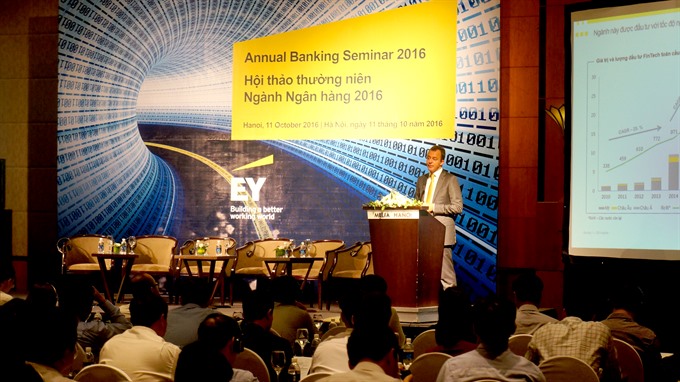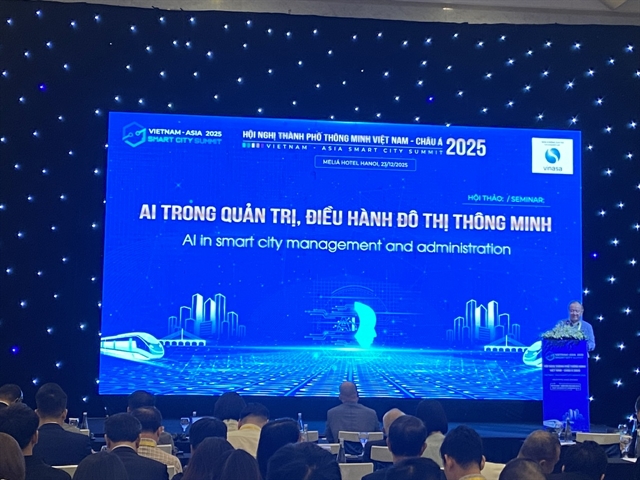 Economy
Economy

As the country moves toward deeper integration, banks are striving to improve their information and technology systems in order to catch up with new trends and to ensure customer safety. Globalisation and interconectivity come with information and technology risks. In addition, the presence of financial technology (fintech) also has reshaped the financial services sector.
As the country moves toward deeper integration, banks are striving to improve their information and technology systems in order to catch up with new trends and to ensure customer safety. Globalization and interconnectivity come with information and technology risks. In addition, the presence of financial technology (fintech) also has reshaped the financial services sector.
Experts told media about fintech and cyber security in the sector during the annual banking seminar held in Hà Nội on Tuesday .
What does fintech mean? How is the fintech developed in Vietnam?
 |
| Jan Bellens |
Fintech is the combination of innovative business models and technology to enable, enhance and disrupt financial services. Fintech has been a prevalent phrase in the past 10-20 years. However, Fintech has recently become a hot isuse for the world’s developing markets.
A survey conducted by EY over the last six months in some big cities in the world—including developed and developing countries—showed that 15 per cent of customers own two or three products relating to the fintech. It means that one in 7 customers actively uses fintech.
There has been a big wave of fintech start-ups in recent years, with a huge quantity of venture capital funds flowing into fintech. In 2015, around US$15 billion was invested into fintech. The amount is expected to reach $25 billion this year. The investment has not been seen in a single market but around the world.
Innovation is appearing across all financial service sectors, inculding online payment and e-commerce, facilitating faster and better payment.
The fintech development in the insurance sector has been slow in previous years. However, the sector has een rapid development of fintech in recent years such as telematics, social insurance and wearables.
As in many other markets, the initial impact in Việt Nam has been to payment services. There will be a lot of new firms in the sector in the boom of fintech. It means that several firms will also face difficulties keeping up with the rapid pace of competition.
Although recent Vietnamese fintech development has focused on mobile payment, online payment and e-wallet, I do believe that the fintech will further develop as it surpasses its early development stage.
I think there are two motivations to make the country become attractive to fintech. The Vietnamese market has some different characteristics in comparison with developed markets. Firstly, many customers either don’t use banks or don’t maximise banking services. Statistics from the annual banking seminar held in Hà Nội on Tuesday showed that around 500,000 Vietnamese people have not used banking services. So this is a gap that could be closed via technological investment.
Secondly, we have seen a clear future for fintech. Traditional banks face significant challenges attempting to react to the speed of fintech development, though Việt Nam has a big number of retail banks. It was the reason that fintech companies with faster and more comfortable services to customers could have opportunities for development.
Start-ups in turn also face their own challenges. The door therefore is open for collaboration with banks and fintech firms to maximise strengths of each other. Banks are trusted, secure and stable while fintech often are customer-driven, exciting and frictionless. However, the banks face difficulties of disconnected engagement, inefficient and complex delivery, while fintech has challenges of brand building, lower regulatory maturity and inability to scale. The collaboration between banks and fintech could bring a bright future.
On one hand, regulators want to develop new business models and support their development. On the another hand, regulators are afraid of risks posed by the new models, such as money laundering, hi-tech criminal, financial and customer system.
Recently, we see a wave of Vietnamese start-ups in Fintech. However, the companies’ scale is small, and they have not devloped strong brands. What should the Vietnamese Government and Fintech firms do improve the situation?
I think the highlight is the challenge of finding corperations that want to co-operate with fintech.
Normally, there are two waves of fintech development. Like many developing markets, Việt Nam has been in the first wave with several small scale businesses. They are finding the most suitable business model for their development.
Fintech firms need four requirements for their development: funding, market vision, entrepreneur sprit and regulators’ supports. Việt Nam needs a big investment to expand their scale to make the companies bigger. The companies need to clarify their target customers. The management agencies should provide open and firm legal framework to help fintech further develop.
When you look at the global response from regulators, you see that they are creating pilot environments where fintech can develop new business models.
A lot of cities--including Singapore, Hong Kong and Sydney--have created such environments and reviewed fintech’s effectiveness before allowing them to provide market services.
 |
| Nguyễn Hòa Bình |
Nguyễn Hòa Bình, chairman and co-founder of Next Tech, Group of Technopreneurs
A main difficulty of online payment is that most customers want to directly see their products. In addition, the weakness of online transactions can be seen in the country’s banking sector. For example, if a customer wants to make an online transaction, it is required that he or she must have a bank card. They have to register for online payment function at banks’ transaction booths. They face several issues through a middle payment unit. Up to 50 per cent of customers use their mobile phones for online purchases, while banks have not allowed mobile payment. This makes customers feel that online payment does not bring them benefits and conveniences that cash on delivery (COD) does.
Banks have not realised fintech’s opportunities to improve services that serve customers. Around 95 per cent of e-commerce has been paid by COD. It is a sad fact for the country as the Government targets a non-cash payment system. It also goes against the world’s trend of e-commerce development. In Việt Nam, online sellers could find it hard to sell their goods if they do not accept COD.
Some shipping firms have collected around VNĐ700 billion a month for e-commerce. It means that the market total’s value could reach VNĐ4-5 trillion.
Fintech has not only revolutionised the financial sector but also sectors such as transport (Uber), restaurants, hotels and telecommunications (Whatsapp).
Around 70 per cent of Vietnamese population has not used banking services. It means that banks leave a big group of customers to fintech, which provides applications to serve customers’ financial demands. Technology companies are building technology to serve financial services, mostly those beyond banks’ coverage.
Fintech has been considered in two angles: as a disruptor and a transformer. The disruptors provide solutions which totally replace bank services, such as the e-wallet. The transformers provide solutions supporting banks to better improve their services and expanding to more non-bank customers.
Several foreign banks have taken solutions to exploit the opportunities. Some open their systems allowing fintech to access their sources to provide better services to customers. — VNS




